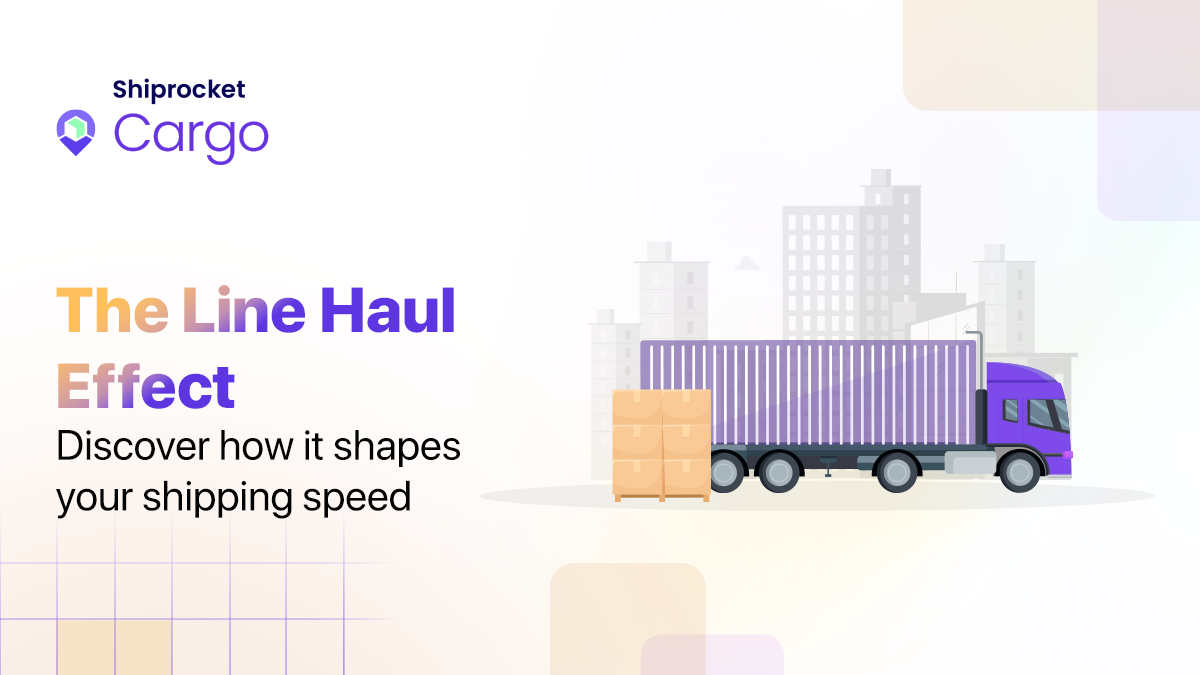How is Cargo Packaging Essential for Safe and Reliable Deliveries?
- What is Cargo Packaging and Why is it Important?
- What are the Main Functions of Cargo Packaging in Logistics?
- What are the Different Types of Cargo Packaging?
- Which Packaging Materials are Commonly Used for Cargo?
- How does Packaging differ for General, Fragile, and Bulk Cargo?
- What Safety and Regulatory Standards Apply to Cargo Packaging?
- How can Cargo Packaging Improve Cost Savings and Sustainability?
- What Best Practices Help Businesses Choose the Right Cargo Packaging?
- How is Shiprocket Cargo Supporting Businesses with Smarter Packaging and Logistics Solutions?
- Conclusion
- FAQs
Indian eCommerce revenue is expected to reach around US$65 billion by 2025, reflecting the rapid growth of online shopping and rising order volumes.
For sellers, this means more shipments and a greater need for reliable cargo packaging. Shipping isn’t just about sending products; it’s about ensuring they reach customers safely and on time. Poor packaging can lead to damaged goods, higher returns, and lost customer trust, which directly affects profits and your business reputation.
Whether you run an online store or a physical business, understanding smart cargo packaging is key to protecting your products, staying compliant with regulations, and keeping customers satisfied.
This blog will look into everything you must know about cargo packaging, its benefits, types, and best practices.
What is Cargo Packaging and Why is it Important?
Cargo packaging is the process of preparing goods for storage, handling, and transportation to ensure they arrive safely. It protects shipments from long-distance travel, rough handling, and changing weather conditions.
For eCommerce sellers, secure packaging prevents breakage, moisture, dust, and tampering. It also helps meet logistics and regulatory requirements, reduces the risk of delays or penalties, and builds customer trust in your brand.
What are the Main Functions of Cargo Packaging in Logistics?
Cargo packaging does more than just protect products; it directly affects delivery efficiency and customer satisfaction. Key functions include:
- Damage Protection: Shields shipments from shocks, vibration, moisture, and dust. For example, fragile electronics in well-padded boxes are less likely to break during transit.
- Compliance with Standards: Ensures packages meet shipping and regulatory requirements, avoiding penalties or rejected shipments.
- Ease of Handling: Properly packed goods are easier for couriers to load, unload, and transport, reducing delays and mishandling.
- Cost Control: Minimises returns, replacements, and product loss, helping maintain profit margins.
- Brand Reliability: Secure, on-time deliveries build customer trust. For instance, consistent safe delivery of products like glassware or cosmetics encourages repeat orders.
What are the Different Types of Cargo Packaging?
Different products require different packaging solutions. Some of the common cargo packaging are as follows:
- Cardboard/Fibreboard: Available in corrugated, double-walled corrugated, and double-carton types. Suitable for a wide range of products, from cosmetics to industrial goods, offering lightweight protection and easy handling.
- Bagged Cargo: Often used for granular or powdered items like grains or cement, bagged cargo packaging requires extra support to prevent tearing.
- Wooden Cases: Known for its durability and versatility, wooden cases are used to transport delicate or high-value products that require high protection.
- Wooden Crates: Often made from plywood or lumber and held together with nails and screws, wooden crates provide ventilation and strength to bulky products, and also make inspection during transit easier.
- Steel Drums: Known for their durability and capabilities to withstand the rigors of shipping and handling, steel drums are used to transport liquids, chemicals, or hazardous materials that need leak-proof containers.
- Bales: Bales are compressed packaging used to transport clothes, paper, and agricultural products to save space.
- Palletising Cargo: These stack items on pallets for easier handling with forklifts, helping improve loading efficiency and reduce damage risk.
- Containers: These are large standard-size rectangular boxes that are used to transport bulk shipments.
Which Packaging Materials are Commonly Used for Cargo?
Choosing the right packaging material not only protects your shipments but also builds customer trust by ensuring products arrive safely. Common materials include:
- Corrugated Cardboard: Lightweight, recyclable, and versatile, suitable for products ranging from small items to larger goods.
- Wood: Used for crates and cases, providing strong protection for heavy or fragile items.
- Steel: Durable, leak-proof, and impact-resistant, ideal for liquids, chemicals, and hazardous materials.
- Plastic: Adds an extra protective layer, often used for cushioning or waterproofing shipments.
- Textile and Jute: Commonly used for bagged cargo such as grains, cement, and other agricultural products.
- Composite Materials: Combines multiple materials to provide enhanced protection for items that require extra strength and durability.
How does Packaging differ for General, Fragile, and Bulk Cargo?
Different cargoes require different levels of protection and handling. Here is how it differs:
- General Cargo: These are generally shipped in cartons, crates, or pallets with standard cushioning.
- Fragile Cargo: These often require an extra layer of padding, bubble wrap, foam inserts, and clear labelling indicating handle with care.
- Bulk Cargo: These are often transported loose, in bags, bales, or containers to prevent damage.
What Safety and Regulatory Standards Apply to Cargo Packaging?
Cargo packaging must meet safety and regulatory standards to protect products, people, and the supply chain. Key requirements include:
- ISPM-15 Wooden Packaging: Wooden crates and pallets must be heat-treated or fumigated to prevent pests from spreading internationally. This is essential for export shipments.
- Hazardous Goods Compliance: Chemicals, batteries, and other restricted items require certified containers, proper labelling, and complete documentation. This ensures safe handling and prevents accidents during transit.
- Weight and Dimension Guidelines: Each courier or freight company sets limits on package weight and size. Overloading can lead to fines, shipment rejection, or increased transport costs.
- Clear Labelling and Barcoding: Proper labelling ensures the right handling instructions, correct delivery, and traceability. It reduces errors and helps couriers manage logistics efficiently.
- International Codes (Optional but Recommended): Following global guidelines like the IMO/ILO/UNECE CTU Code helps sellers pack containers safely, avoid cargo shifts, and reduce damage risk.
How can Cargo Packaging Improve Cost Savings and Sustainability?
Smart cargo packaging helps sellers reduce costs and contribute to a greener supply chain. Using the right size and type of packaging:
- Lowers shipping weight: Reduces transportation costs.
- Minimises material waste: Avoids excess packaging and unnecessary expenses.
- Cuts return and replacement costs: Protects products from damage during transit.
What Best Practices Help Businesses Choose the Right Cargo Packaging?
Here is how you can choose the right cargo packaging for your shipments:
- Carefully assess your cargo type, weight, and fragility. It helps you determine packaging strength and materials.
- Consider environmental factors such as temperature, humidity, and potential water exposure.
- Choose packaging material that meets shipping and safety regulations.
- Look for cost-efficiency without compromising protection.
- Ensure ease of handling with standard sizes, labelling, and compatibility.
- Test your packaging solutions to evaluate performance.
How is Shiprocket Cargo Supporting Businesses with Smarter Packaging and Logistics Solutions?
Using the right cargo packaging with smart logistics tools enhances efficiency and reliability. Shiprocket Cargo helps sellers ship safely while saving time and cost. It supports all types of shipments, including general, fragile, high-value, or bulk, ensuring they reach customers in perfect condition.
Here is how this platform supports your business:
- The rates start at Rs. 6/kg.
- Delivers to 24000+ pin codes.
- Real-time tracking for you and your customers.
- Access to multiple carriers. You can choose the one according to your needs.
- 24/7 dedicated support.
- AI recommendations to help you choose the best courier partner.
Conclusion
Secure cargo packaging is essential for sellers to deliver their products to their destinations safely and in good condition. It prevents damage, builds customer trust, and reduces unnecessary losses during transit.
Sellers who prioritise well-planned packaging protect their profit margins by lowering the return cost. And including smart tools like Shiprocket Cargo allows the ease of hassle-free cargo planning.
FAQs
A well-planned cargo packaging protects products from damage and ensures smooth handling during logistics.
In addition to cardboard, wood, steel, plastics, and textiles, consider reinforced or composite materials for fragile, high-value, or temperature-sensitive shipments to ensure maximum protection.
A proper use of cushioning and structural support in your packaging prevents breakage, spills, and deformation during handling and shipping.
Yes, many modern eco-friendly packaging materials like reinforced kraft paper, moulded fibre, and bio-based plastics offer durability and protection.
Using oversized boxes, poor cushioning, low-quality tape, or ignoring weight distribution can lead to product damage and higher shipping costs.



